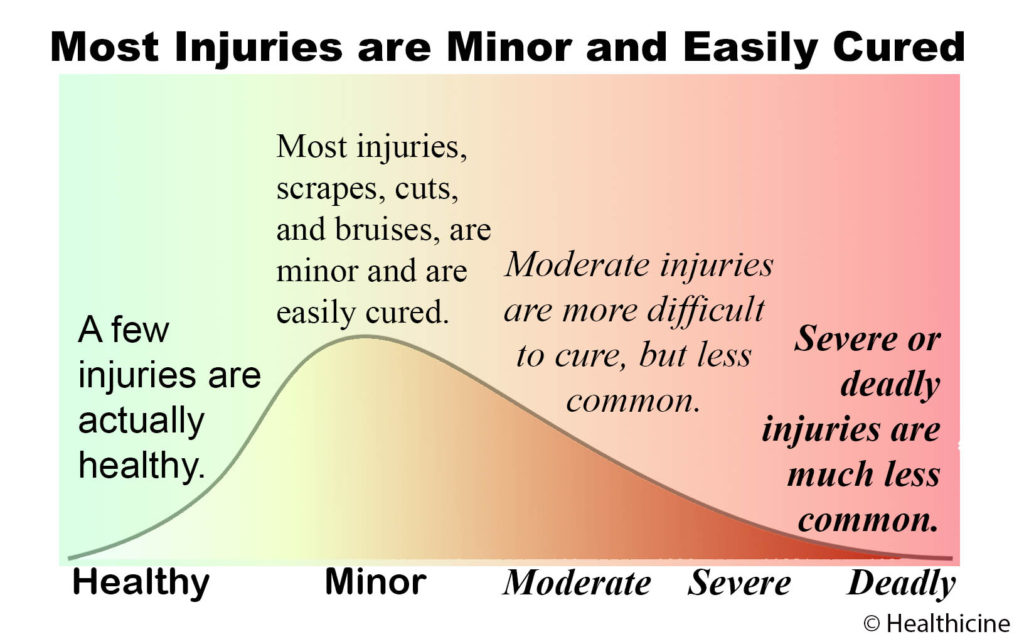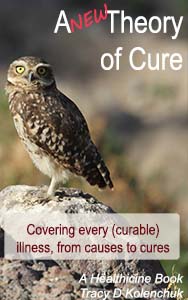We might easily be led to believe that cures are rare, even impossible. After all, “there is no cure for the common cold.” However, after studying the concepts of cure for several years, I made an interesting discovery:
“Most illnesses are elementary, having a single cause, at least in the first stages, and thus most cures are simple, so simple that they are generally ignored.”
– A New Theory of Cure.
Can this be true? The book A New Theory of Cure explores cure from several angles. What are the most common illnesses? Probably minor injuries. This post looks at injury illnesses – and the trivial nature of most cures. The next post looks at infectious illnesses – and we can easily see that most infectious illnesses too are easily cured.
“Most injuries* are trivial, cured without access to a doctor – it has always been so.”
– A New Theory of Cure
Think about it. We get a minor cut, maybe a paper cut. It heals, cured. We get a small or large bruise. It heals. Cured. We burn our finger on the stove – and unless it is serious, we lick our finger and it heals. When cut is larger, we might apply an bandage, perhaps an antibiotic. And it heals. Cured. Most injuries are minor, cured without even consulting a doctor, much less any medical treatment. Someone who suffers serious a serious cut or burn needs medical attention, but most burns are not serious. Small injuries (and our communities) teach us to avoid more dangerous ones. We only seek medical attention when the cut is so serious that we need stitches.
When we think of diseases – we might not think about injuries. But, the emergency entrance is the busiest place in a hospital, and most hospital and medical clinic admissions are injuries. In war and in peace, most illnesses are injuries, many self-inflicted, most easily cured. The World Health Organization maintains disease codes, and tracks disease statistics for injuries worldwide. Injuries are diseases.
However, once an injury is diagnosed and documented as a disease – in medical theory (or the absence of medical theory), it can’t be cured. Cured is not medically defined for injuries – no matter how trivial, or how serious they might be. A doctor might say “all better“, or “you’ve recovered“, but only rarely, if at all, “you’re cured.“
Although we have no medical or scientific studies of ALL injuries, this graph is a useful representation of the frequency of different severity levels of injuries.

We might get hundreds of minor cuts and bruises, without ever seeing a doctor, for every broken bone or severe injury. It is also likely that most moderate injuries, like many minor bone fractures, are never diagnosed, much less treated by a doctor, much less cured. We often minimize our own injuries and illnesses – and in most cases, we survive, our bodies, minds, spirits, and communities step up to cure them. Note: In the new theory of cure, injuries – not the patient – are cured.
A few illnesses are actually healthy. That might seem counter-intuitive, but it’s not hard to think of a few examples. When we are about six years old, our teeth fall out, our gums open up, sometimes even minor bleeding, as our adult teeth grow. When we go back farther, it’s common for babies to cry a lot when baby teeth start to push through the gums. We just don’t call “teething” and injury. But it breaks the skin, and the skin heals. Healthily.
The pain of minor injuries is often a healthy lesson. When we get a minor burn, we learn to not touch the stove. Most burns are minor. It’s harder to get a serious burn. Our communities protect us in many ways. In addition, to live well, we need to take risks – we need small injuries, for the health of it. We cannot excel without risk, without injury.
Body, Mind, Spirits, Communities
It’s not just physical injuries that are easily cured. Even the proverbial “whack on the the head” might be an injury in the short term, healthy in the long term.
As with physical injuries, we often suffer minor injuries to our mind or to our spirits. However, modern medicines treat the body – most illnesses in our minds and spirits are simply ignored, even by psychologists. Most are cured naturally, easily, and the cures are ignored.
In addition to physical symptoms like hangovers and loss of sleep, we might suffer from minor anxiety, depression, psychosis, or attention deficits due to stress, lack of sleep, or overuse of drugs from alcohol and caffeine to more powerful medical and recreational products. We withdraw from our communities, often avoiding those that might even support or cure us. In most cases, the cure comes easily when we address the cause – intentionally or not. Most mental injuries are minor, easily cured.
However, if a disease is diagnosed, a cure becomes theoretically impossible. Cured is not defined medically for depression, psychosis, attention deficit disorder – not defined for any diagnosable mental disorder.
Curing Injuries?
Our current medical systems treat injuries. The word cure is. rarely used. We get a cavity or perhaps a broken tooth. The dentist repairs it with a filling, but doesn’t say “cure“. We get a cut that requires stitches. A doctor or nurse sews the skin together – and it heals. The word cure is rarely, if ever, used.
Patients with serious injuries are often patched up at the hospital and sent home to recover. Even in cases where medical assistance – physical rehabilitation – is required and fully or partially successful, the word cure is not used. At home recovery is rarely tracked, unless it fails. When the injury or injuries are healed – cured – the doctor might not see the patient until the next visit. Many patients don’t have a family doctor – and never return after a cure. Like minor injuries, the cure is forgotten. Not documented. Not studied.
Cures are not Studied
We have hundreds of cases of injures for every one that is treated by a doctor. Most are cured – out of sight of medical practice and medical theory. Hippocrates said “What cannot be cured by medicaments is cured by the knife, what the knife cannot cure is cured with the searing iron, and whatever this cannot cure must be considered incurable.” Nonsense. Most illnesses are easily cured by our healthy bodies, minds, spirits, and communities – outside of the sight of medical doctors and researchers.
What happens when an Injury is Cured?
The cure is ignored. It makes no difference if the cure was caused by a doctor, a nurse, an alternative medical practitioner, a grandmother, or the patient. We ignore cures of injures – and get on with life.
- In modern medical theory cured is defined for an infectious disease cured by an approved medicine that kills the infectious agent, or a surgery that removes it. All other diseases – including all injuries – can be considered incurable due to an absence of a definition, much less a test of CURED.
Most cures are easy, trivial – and ignored. This is true for all types of diseases, not just injuries. Modern medicine suffers from cure denial.
When we fail to study the easiest, the simplest, the most trivial cures, we view many curable conditions as incurable. Today, we have no scientific studies of healing – the curing of injuries. They are not medical cures.
Health is whole.
An illness is a hole in health.
A cure fills the hole.
It’s time to study cure.
The book A New Theory of Cure explores the concepts of cure, beginning with elementary illnesses, easily cured, which when uncured can grow to more complex and compound illnesses, more difficult to cure.
This post was first published on the blog
* In the book A New Theory of Cure, and in this post, I take care to distinguish between illness, disease, and sickness.
- an illness is what the patient has
- a disease is what the doctor diagnoses
- a sickness is what the patient’s community sees (every patient lives in many communities with potentially many different views).



